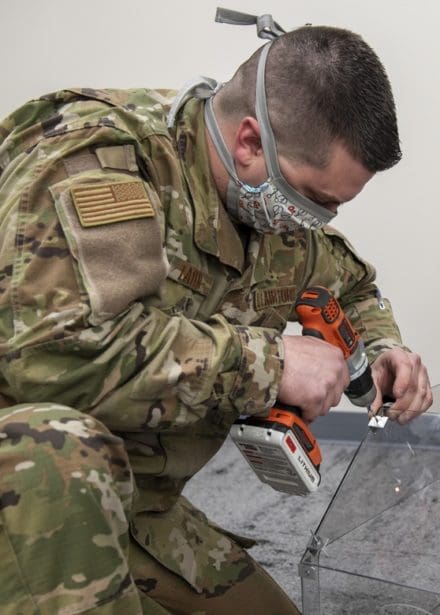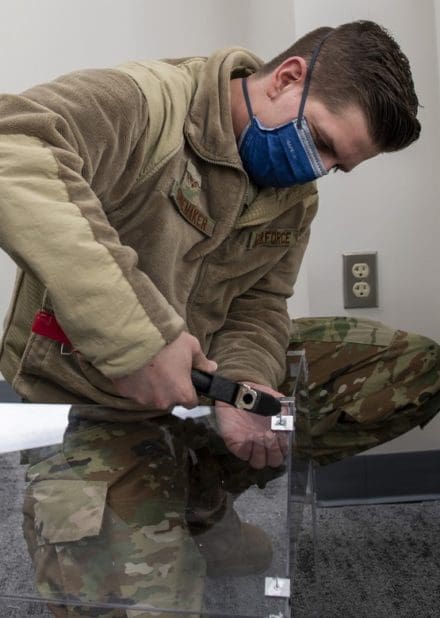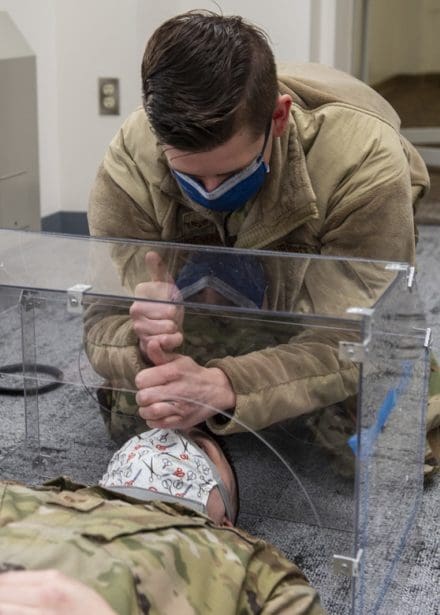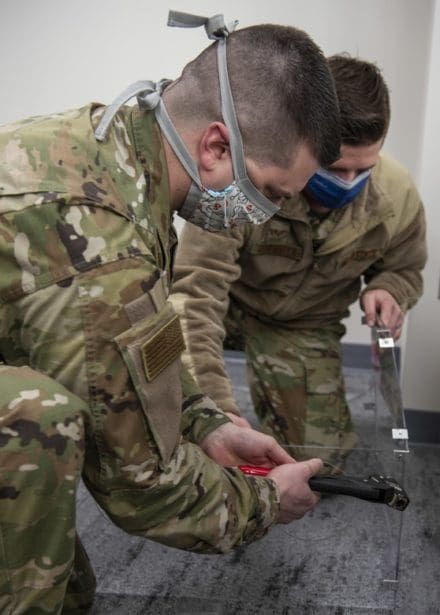JOINT BASE ELMENDORF-RICHARDSON, Alaska
Two 673d Medical Support Squadron (MDSS) Airmen refined their invention of a plastic barrier to protect medical providers treating patients with COVID-19, and airborne diseases in general, at Joint Base Elmendorf-Richardson, Alaska, April 7, 2020.

U.S. Air Force Senior Airman Michael Shoemaker, 673d MDSS biomedical equipment technician, and U.S. Air Force Staff Sgt. Andrew Taylor, 673d MDSS medical logistics noncommissioned officer in charge of acquisitions, designed and built a polycarbonate plastic enclosure to place over a patient’s head and upper torso with access for treatment via two holes at the head of the enclosure for a physician’s hands and arms, and two side doors for additional access.
“Ultimately, we wanted to create a mobile isolation room that could contain an infectious disease,” Shoemaker said. “This enclosure provides an extra layer of protection for medical staff because aerosol droplets can’t pass through it.”
Shoemaker said he got the idea after seeing the large, bubble-like ventilators medical providers in Italy and New York were using to treat patients with COVID-19. The ventilators had sufficient space around a patient’s head for a physician to reach inside and treat the patient from outside the barrier.

Shoemaker shared his idea for a sturdy, plastic barrier that could surround a patient’s head and upper torso with MDSS leadership, using a cardboard box for a visual. He said his leadership immediately gave him the go-ahead to build a prototype, and Taylor came on board to help with supplies and construction.
Taylor and Shoemaker built an acrylic prototype that same day, then invited medical professionals from infection control, respiratory therapy and anesthesiology to provide feedback and suggestions for improvements. A paramedic also intubated a medical manikin under the enclosure to assess its practicality.
“It was really cool to see the whole team excited about the idea, looking at the capability it could provide,” Shoemaker said. “Everybody was onboard. They pointed out shortfalls in the initial design and what we needed to change. For example, curving the front so there wasn’t a seam on the viewing platform, and making sure there were doors on the sides so medical technicians could support the physician.”

“Their recommendations made this enclosure a lot more functional than we originally anticipated,” Taylor said. “It could be used for more than the current situation with COVID-19. It could be used for almost any medical procedure needing an extra barrier for protection.”
To create the enclosure, polycarbonate plastic panels are cut with a waterjet, so they fit together almost like a puzzle. Thin brackets and rivets secure the panels together, and clear silicone seals the seams. The team is also working to create a single panel that can be folded into shape using heat, eliminating the need for brackets and rivets.
“It’s simplicity allows it to be quickly cleaned and sterilized after each use and ready for another patient in five to 10 minutes,” Taylor said.
“Working with the base innovation lab and the staff at the medical group, we’ve created something significant,” Shoemaker said. “If this is adopted and we’re able to make this a kit that can be sent out, it will outlast COVID-19 and go to any medical group with a need for it.”

In less than a week, with help from the 673d Medical Group, the JBER Innovation Lab and support from across the installation, these two Airmen created a functioning, potentially life-saving device.
By Airman 1st Class Samuel Colvin | 673 ABW/PA

